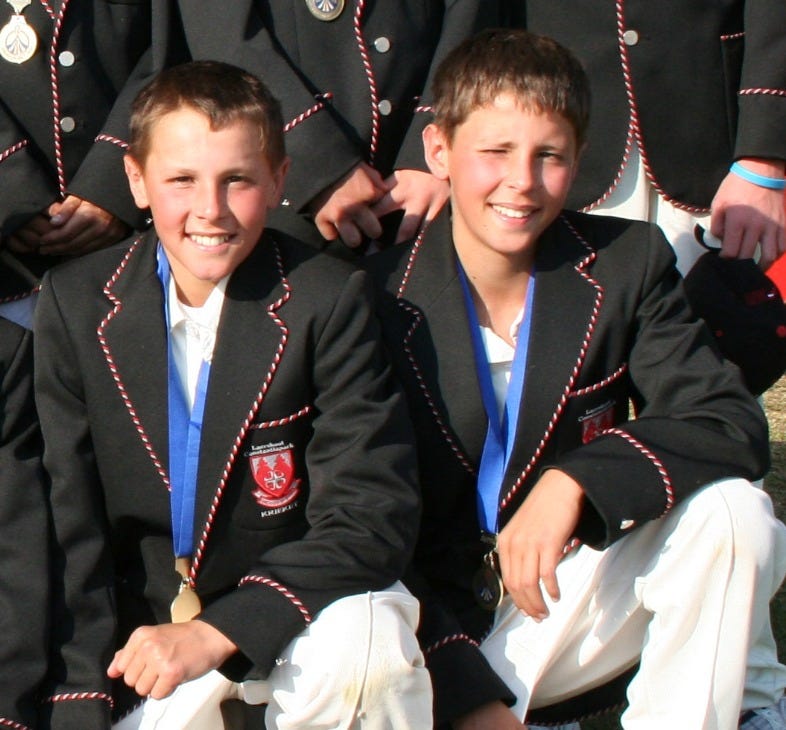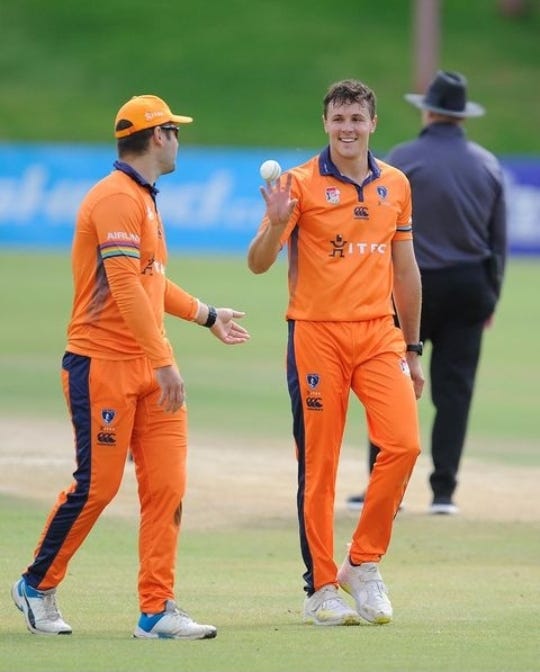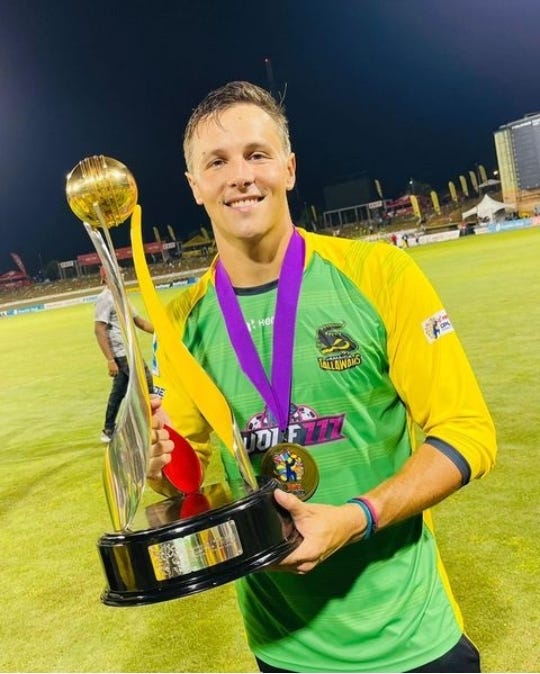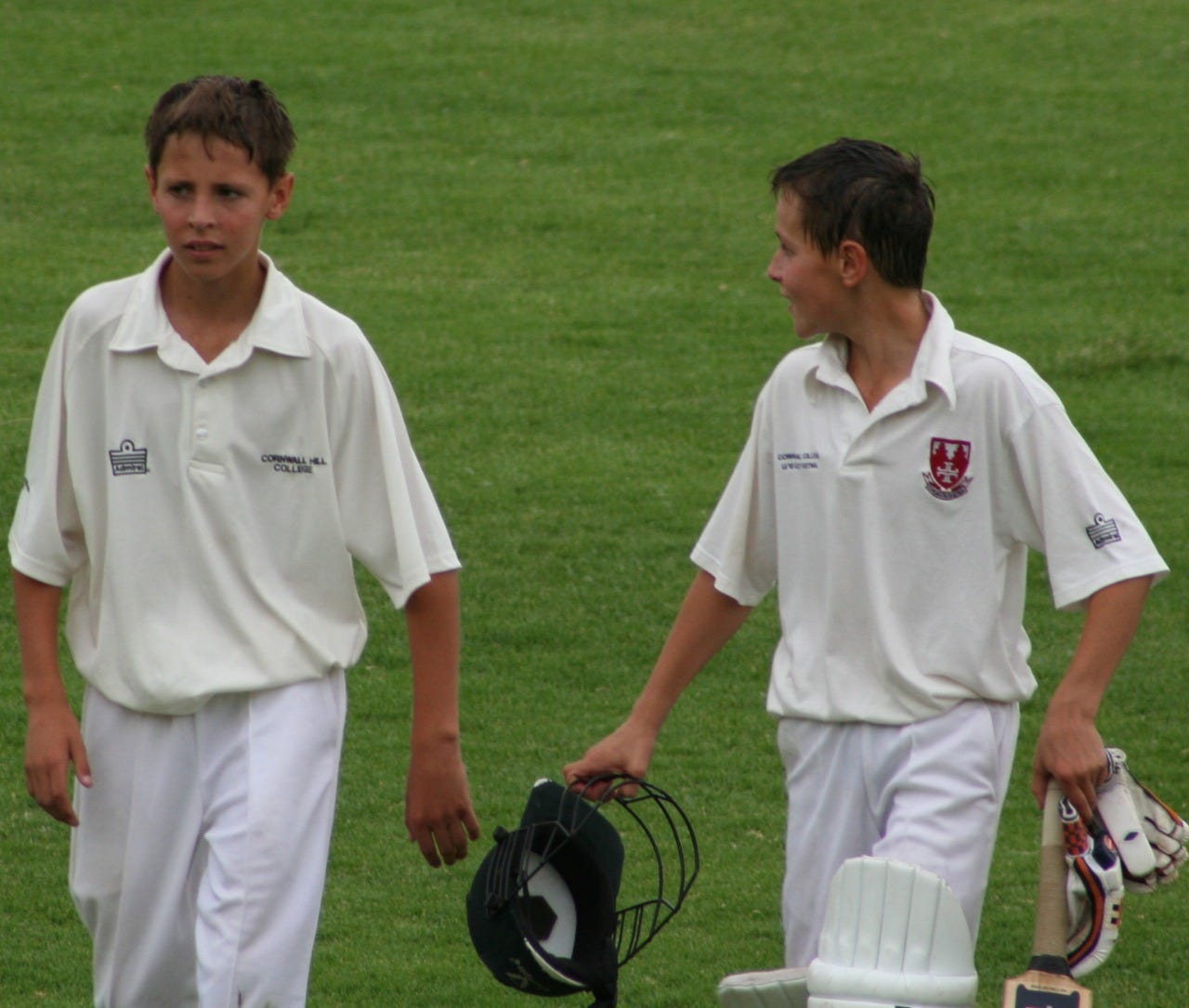The “Uncapped Picks” series continues with a new piece, an essay on Migael Pretorius. “Uncapped Picks”, as the name suggests, features the six uncapped players picked by SA20 franchises before the auction. These pieces are designed to bring these incredible players closer to you, the fans. Draw the curtain and allow you to look into their world. We’ll have a new “Uncapped Picks” essay over the next few weeks. It should be really fun. Thanks, as always, for your support!
No. 1 Ottniel Baartman
No. 2 Dewald Brevis
No. 3 Gerald Coetzee
“The mark of a really top bowler is how they respond when their tricks aren’t new anymore. And that happens so much faster now,” Nakul Pande, an associate producer with Sky Sports, observed.
Back in the day, Muralitharan had to do a TV special showing how he bowled to save his career. And just when every batter thought that had been handed a cheat sheet against the great spinner, Muralitharan opened another bag of tricks.
The only way to remain effective is to keep ahead of the curve. Migael Pretorius does his best to stay ahead of the curve.
Hello, welcome to Stumped! If you are not yet a subscriber, join more than a thousand other professional athletes & ex-pros, coaches, commentators & analysts and casual sports fans that receive the newsletter in their inbox each week — it’s free:
To bowl a standard leg cutter, this is how you grip the ball. If you don’t have a cricket ball, take a tennis ball - a good-sized apple or orange might do as well. The grip is a three-finger grip. The middle finger straddles the seam or middle of the fruit, the index finger is at a wide angle down on one side of the ball and the thumb anchors the lower part of the ball.
As the ball is leaving your hand, rotate your hand slightly as if you were turning a door knob to open a door. As you do this, drag your middle finger down the side of the ball. Right-arm bowlers will be dragging their middle finger down the left side. Left-arm bowlers drag the middle finger down to the right.
Migael Pretorius’ grip is not that much different. His middle finger does not straddle the seam, it is on the outside part of the seam, to the left. Done well, this will impart sidespin, slow the ball a little more and take it away from the right-hander. Get it wrong and he would serve the batter a juicy half-volley or a ragged long-hop.
Leggies are a great option if there isn’t a lot of seam movement/swing on offer. They are also a valuable option if the batters are in slog mode. During the Abu Dhabi T10 tournament in 2019, there was little to no seam movement on offer. T10 is a slogfest.
When Pretorius joined Deccan Gladiators, he had a dependable off-cutter. Unfortunately for him, the batters were finding it easy to line it up for big hits. He couldn’t bowl a succession of yorkers and neither could he go to his back-of-the-hand slower ball. He had shelved it after it gave him shoulder problems. Opposition batters were reading Pretorius' other variations like an open book and he needed something to counter the onslaught.
It takes guts to debut a leg cutter at a T10 tournament without much off-season work. According to Allan Donald, Pretorius' stocks of self-belief are through the roof. Generally, bowlers develop variations during the off-season. That is when they have the time to tinker with the delivery to perfection. Pretorius did not have that luxury in 2019.
The leg cutter was not a part of his arsenal, but he had fooled around with it in his back garden. Nothing serious. However, when he executed it, it was as if dormant muscle memory had been awakened.
“Migael is a ferocious learner and things come so easily and naturally to him,” says Mark Charlton.
When he was younger, Migael Pretorius decided that he would follow in his father’s footsteps and make a career for himself as an electrical engineer. Like his father, for him, cricket was a pastime. A way to compete with his twin brother, Kristiaan. If anyone entertained thoughts of pursuing the sport professionally, the odds could have been on it being Kristiaan. He loved the game more. Kristiaan still plays Last Man Stands each year.
The twins also played Bakers’ Mini Cricket (now KFC mini cricket) together. There was also bulletjie rugby more - rugby’s version of mini cricket - during their time at Erladus Park primary school. In later years, at Constantia Primary and Waterkloof High schools, Migael would drift from cricket and pay more attention to athletics - he was a good runner and used his strong arm to throw the javelin.
It was only towards the end of his Grade 11 year that Migael turned his attention to cricket.
Waterkloof High has a proud history as a cricketing school. Not on the level of Grey High, but they are up there. Each year, tens of learners with dreams of playing professional cricket enrol at Waterkloof. Janneman Malan decided early on that Waterkloof was the school he wanted to attend to give his ambitions a better chance.
The school team was not short of players when Johan Muller invited Migael Pretorius to train. “He said to me, ‘listen, do you want to come on? We have this unique opportunity for you and I'll teach you everything you need to be a good cricketer,” says Pretorius. “He convinced me that it was something that I should consider and it was something that I could be very good at if I worked hard in really pursuing the dream that many others really want.”
When he accepted the invitation, Pretorius started in the fourth team. Bottom of the pile. But Muller saw something special in Pretorius. He was convinced the boy had more ability and potential than he realised. So he invested time in the teen. When Pretorius suffered a stress fracture, Muller worked with him to streamline his bowling to prevent future injuries.
Muller had a cricket dream for Pretorius before Pretorius had a cricket dream for himself. The only time Pretorius had dared to dream of being a professional cricketer was when he played against Kristiaan in the backyard when they were little, as every youngster who watches cricket on TV does. But, it was never serious. For Pretorius, Migael Pretorius the electrical engineer sounded better and more realistic than Migael Pretorius the professional cricketer.
By the end of his matric year, Pretorius had worked his way up to the first XI. Things came easily and naturally to him.
This Substack column exists thanks to patrons and readers that leave tips. Stumped! is wholly supported by Readers Like You. To keep the weekly posts coming and to keep the lights on here, consider leaving a tip or supporting monthly on Patreon. You won’t regret it!
When he was on the cusp of being 20 years old, Migael Pretorius was promoted to the Northerns first team. On his first day after being promoted from the SSE Academy, Pretorius arrived late for the match.
Pretorius had joined the SSE Academy on the strength of Johan Muller's recommendation. The academy provided Pretorius with two things every aspiring cricketer needs: structure and direction.
During his first two years at the academy, Pretorius played second and third-team cricket. During that time, Cardoso and Charlton fine-tuned his technique. “At Waterkloof, he depended on pace, he was big and fast. But at club level and going up, pace alone would not be enough. He did not bowl in the upper 140s. He is a swing bowler and is most effective when he bowls a consistent line,” says Mark Charlton.
Pretorius is at his most dangerous when he looks like he is not doing much and yet keeps the batters quiet. According to Charlton, some of Pretorius’ finest innings are when he did not walk away with many wickets. He set the stage for others to reap the rewards of controlled bowling.
Discipline is another thing he walked away from the academy with. After two years of cricket for the Titans Colts, he was promoted to the Northerns team. But he was in the Northerns team as the 12th man. And he was late by five minutes. Mark Charlton laid into him for his tardiness. A couple of senior players had a stern word with him.
“He was surprised by how much of a big deal this was,” says Charlton.
At high school cricket or maybe club cricket, this would not have been a big deal. Other benchies would have stepped in and covered for him. But, this was neither club nor school cricket. This was senior provincial cricket. The twelfthy is the next player in line and carries a huge responsibility to the players in the first XI.
This was his first brush with high standards. It was the first and last time he was late. Over the next 12 months, Pretorius carried the drinks for the team and was always one of the first players to arrive. When he eventually got a match, Pretorius bowled 10 overs on the trot and conceded less than 15 runs in his allotment. That is how he announced himself to semi-professional cricket. The match was against Tuks. He took to that level like a duck takes to water.
This newsletter also reaches more people because you share it with others:
After his stint with the Northerns, Pretorius bounced around the league for a little bit. Teams brought him in for a job, which he did, but they didn’t offer him much in return.
Pretorius made his Titans debut in the Jusksei derby. He did Pretorius things: he kept the Lions batters quiet. But, the Titans could not give him regular game time, and their neighbours across the Jusksei river were more than happy to offer him a spot. But, as a stop-gap measure.
Pretorius made the best of his one chance with the Lions. In one of the few matches that he played for the Lions, he did for them against the Knights what he did for the Titans against them. But, his best was not enough for the Lions. They let go of him shortly afterwards. He moved to the North West Dragons for a season, and then when Allan Donald needed a new ball bowler, he came calling.
“I had spotted him about a year before. He was an unknown then,” says Allan Donald. “He had great energy, great intensity. He puts his money where his mouth is.”
Pretorius was fantastic for the Knights. So fantastic he caught the eye of T10 scouts. He made the SA A team and joined the Mumbai Indians as a net bowler. Then the Jamaica Tallawahs in the CPL. Each team provided him with a learning point. His first year with the Tallawahs was okay, not superb.
"But Rovman Powell believed in me. He is that kind of captain, he backs his players,” says Pretorius. “Our team changed a little bit but the core players stayed the same was one or two big players coming in that he felt was going to help him win a trophy.”
Pretorius did even better in his second season. Things came together for him. He helped the Tallawahs to the CPL title.
The twins were a menace. Migael and Kristiaan damaged the lawn with their cricket contests. Every afternoon they were at it, right on the lawn. They waged endless battles against each other using one of those swing balls that have rubber on one side and a tennis ball on the other. To save his lawn from further damage, the twins’ father constructed nets for them. The nets were built close to the garage. This was supposed to be where they wage their never-ending battles without endangering the lawn or windows.
But, boys will be boys. Migael and Kristiaan preferred the expansive space on the lawn to the restrictive nets.
During the offseason, Dinesh Karthik and Abhishek Nayar, his long-time coach, go from one town to town hiring remote stadia and 11 players - bowlers and fielders - with one intention: to work on specific scenarios that might arise in a T20 match. On a single day, Karthik might work on something like getting 14 runs off the last over against a left-arm seamer. He spends about three hours facing as many left-arm seamers as he can find.
The concrete-surface nets that his father built for Migael and Kristiaan no longer serve the purpose of improving his skill as they might have when he was seven or eight years old. He also does not have the IPL money to do what Dinesh Karthik does. So, Migael Pretorius came up with an alternative. First, he bought his own bowling machine so that he could practice his batting at home. He also constructed proper nets, not concrete pitch nets, but nets with a proper pitch.
“Migael is a curious cricketer. He doesn’t just want to know why something works, he also wants to know why something doesn’t work,” says Mark Charlton.
15 years before Malcolm Gladwell published Outliers, Anders Ericsson published a study that reported that the ‘estimated accumulated hours of practice’ was 10 000 hours of practice. The study revealed that expert musicians logged in more hours of practice than amateurs. They were not simply more gifted, they invested more time in deliberate practice.
In 2000, neuroscientist Eleanor Maguire conducted a study with London taxi drivers that tied in with Ericsson’s research and confirmed that the human brain grows and changes in response to training. Pretorius has no idea who Anders Ericsson and Eleanor Maguire are, but he is the embodiment of their studies.
When he is not working on his craft in at home or with the Knights, Pretorius visits his old stomping grounds the SSE Academy. Given his schedule, Pretorius does not get a lot of opportunities to visit, but he makes the effort. At least once a month. Sometimes it is to work with Cardoso on something. Sometimes it is to work with upcoming cricketers. He is always ready to help out at the academy that moulded him when he has the time.
The natural athleticism is there, but Pretorius’ superpower is his dedication to his craft. “Things come easy to him because he does a lot of work in the background,” says Chris Cardoso.
“I have no control over where life will take me, but I am responsible for what I learn,” says Migael Pretorius.











